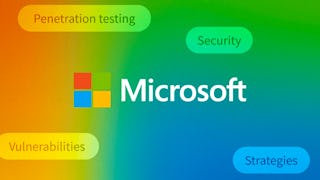This course provides a comprehensive understanding of cybersecurity operations and Microsoft security technologies, integrating fundamental concepts with advanced threat detection, remediation, and automation tools. You will explore core principles of Microsoft Defender XDR, Microsoft Sentinel, and Azure security solutions, learning how to investigate, respond to, and mitigate cyber threats effectively.



Exam Prep SC-200: Microsoft Security Operations Analyst

Instructor: Whizlabs Instructor
Included with 
Recommended experience
Skills you'll gain
- Azure Active Directory
- Computer Security Incident Management
- Endpoint Security
- MITRE ATT&CK Framework
- Cyber Operations
- Threat Detection
- Hybrid Cloud Computing
- Threat Management
- Cloud Security
- Cloud Computing
- Cyber Threat Intelligence
- Incident Response
- Cyber Threat Hunting
- Malware Protection
- Microsoft Copilot
- Incident Management
- Security Information and Event Management (SIEM)
- Vulnerability Management
- Endpoint Detection and Response
- Microsoft Azure
Details to know

Add to your LinkedIn profile
May 2025
15 assignments
See how employees at top companies are mastering in-demand skills

There are 6 modules in this course
This week provides a comprehensive introduction to Azure AI and Machine Learning services, focusing on their core capabilities, components, and real-world applications. Learners will gain insight into the tools and technologies that drive intelligent solutions on Azure and explore the role of a data scientist in the AI development lifecycle. This week also covers key machine learning concepts, the various types of AI workloads, and how to evaluate the effectiveness of AI solutions. Additionally, learners will become familiar with Microsoft’s Responsible AI principles and best practices, equipping them to design and implement ethical, secure, and inclusive AI systems.
What's included
19 videos2 readings3 assignments
This week, we will dive into advanced security configurations, endpoint protection strategies, and Defender for Endpoint (MDE) integrations with Azure Arc. You will gain insights into how Microsoft Defender XDR enhances device security, particularly for non-Azure and unmanaged devices. We begin by exploring how Azure Arc integrates with Defender for Endpoint, enabling security teams to protect and manage devices outside traditional cloud environments. You’ll also learn the process of onboarding non-Azure devices to Microsoft Defender for Endpoint (MDE) through both theoretical explanations and hands-on demonstrations. By the end of this week, you will have a deep understanding of endpoint security enhancements, enabling you to configure, monitor, and protect devices efficiently with Defender for Endpoint and Sentinel.
What's included
30 videos1 reading3 assignments
Welcome to Week 3 of the SC-200: Microsoft Security Operations Analyst course. This week, we will explore the powerful capabilities of Microsoft Sentinel, a cloud-native SIEM (Security Information and Event Management) and SOAR (Security Orchestration, Automation, and Response) solution. Sentinel enables security teams to collect, analyze, and respond to security threats across hybrid environments using built-in connectors, automated playbooks, and advanced analytics. As we progress, you’ll be introduced to Kusto Query Language (KQL) and its role in security incident investigations, filtering logs, joining tables, and analyzing threat patterns. Through hands-on exercises, you will develop custom analytics rules, set up STIX/TAXII threat intelligence feeds, and configure automated playbooks using Logic Apps. By the end of this week, you will have the expertise to deploy, monitor, and optimize Microsoft Sentinel for proactive security analytics, ensuring efficient incident response and anomaly detection.
What's included
20 videos1 reading3 assignments
Welcome to Week 4 of the SC-200: Microsoft Security Operations Analyst course. This week, we will focus on Microsoft Security Exposure Management, cloud security solutions, and governance strategies within the Microsoft Defender ecosystem. We begin by exploring Security Exposure Management, understanding its role in identifying security risks, prioritizing remediation efforts, and optimizing cloud security posture. You’ll also examine the new alert suppression experience, improving incident response workflows to minimize unnecessary alerts and enhance security monitoring efficiency. Next, we will dive into Microsoft Sentinel’s data ingestion optimization, exploring how to refine log management, enhance behavior analytics, and implement best practices for proactive security insights. Throughout the week, we’ll cover essential cloud security solutions, including Microsoft Defender for Cloud, Defender for Office 365, Defender for Cloud Apps, and Defender for Cloud Workload Protection, ensuring seamless security governance and compliance across enterprise environments. By the end of the week, you will develop practical expertise in managing cloud security risks, implementing policies, and utilizing Microsoft Entra ID protection for identity threat detection. You will also gain insights into Azure Lighthouse, which enables secure management of cloud resources across multiple tenants.
What's included
16 videos1 reading2 assignments
This week, we will focus on proactive threat hunting techniques, leveraging Microsoft Sentinel, MITRE ATT&CK frameworks, and advanced security queries to detect and respond to sophisticated cyber threats. We begin by understanding threat hunting fundamentals and how security analysts use structured methodologies to identify potential vulnerabilities before they escalate into incidents. You will explore the MITRE ATT&CK framework, gaining insights into attacker tactics, techniques, and procedures (TTPs) to improve security detection and response strategies Next, we will dive into threat hunting queries, covering query-building principles, filtering techniques, and practical demonstrations within Microsoft Sentinel Livestream. You’ll also learn how to enhance security operations using the SOC efficiency workbook, enabling teams to streamline investigations and optimize security workflows.
What's included
12 videos1 reading2 assignments
This week, we will explore Microsoft Copilot for Security, an AI-driven security assistant designed to enhance threat detection, incident response, and security operations efficiency. You will gain insights into how Copilot leverages AI to accelerate security investigations, helping organizations identify threats, assess risks, and automate response workflows. Next, we will explore Microsoft Security Copilot's best practices, focusing on how to integrate Copilot into security workflows, manage plugins, optimize file handling, and connect security data sources using built-in connectors. You will also learn about permissions management, cost monitoring, and operational considerations for deploying Copilot in enterprise security environments. To solidify your understanding, we will conduct hands-on demos, showcasing how Copilot assists in incident analysis, threat detection, and risk investigation. By the end of this week, you’ll have a comprehensive understanding of Microsoft Copilot for Security, including its role in modern security strategies, exam preparation insights, and career pathways in AI-driven cybersecurity.
What's included
16 videos2 readings2 assignments
Earn a career certificate
Add this credential to your LinkedIn profile, resume, or CV. Share it on social media and in your performance review.
Instructor

Offered by
Explore more from Security
 Status: Free TrialStatus: AI skills
Status: Free TrialStatus: AI skillsMicrosoft
 Status: Free Trial
Status: Free Trial Status: Free Trial
Status: Free Trial
Why people choose Coursera for their career





Open new doors with Coursera Plus
Unlimited access to 10,000+ world-class courses, hands-on projects, and job-ready certificate programs - all included in your subscription
Advance your career with an online degree
Earn a degree from world-class universities - 100% online
Join over 3,400 global companies that choose Coursera for Business
Upskill your employees to excel in the digital economy
Frequently asked questions
To access the course materials, assignments and to earn a Certificate, you will need to purchase the Certificate experience when you enroll in a course. You can try a Free Trial instead, or apply for Financial Aid. The course may offer 'Full Course, No Certificate' instead. This option lets you see all course materials, submit required assessments, and get a final grade. This also means that you will not be able to purchase a Certificate experience.
When you purchase a Certificate you get access to all course materials, including graded assignments. Upon completing the course, your electronic Certificate will be added to your Accomplishments page - from there, you can print your Certificate or add it to your LinkedIn profile.
You will be eligible for a full refund until two weeks after your payment date, or (for courses that have just launched) until two weeks after the first session of the course begins, whichever is later. You cannot receive a refund once you’ve earned a Course Certificate, even if you complete the course within the two-week refund period. See our full refund policy.
More questions
Financial aid available,


